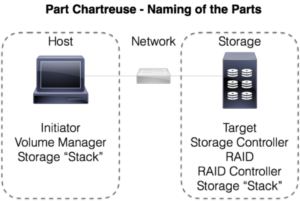Many times we know things without even realizing it, or remembering how we came to know them. In technology, this often comes from direct, personal experience rather than some systematic process. In turn, this leads to “best practices” that come from tribal knowledge, rather than any inherent codified set of rules to follow.
In the world of storage, for example, it’s very tempting to simply think of component parts that can be swapped out interchangeably. Change out your spinning hard drives for solid state, for example, you can generally expect better performance. Change the way you connect to the storage device, get better performance… or do you?
Storage is more holistic than many people realize, and as a result there are often unintended consequences for even the simplest of modifications. With the ‘hockey stick-like’ growth in innovation over the past couple of years, many people have found themselves facing terms and concepts in storage that they feel they should have understood, but don’t.
These series of webcasts are designed to help you with those troublesome spots: everything you thought you should know about storage but were afraid to ask.
Here, we’re going to go all the way back to basics and define the terms so that people can understand what people are talking about in those discussions. Not only are we going to define the terms, but we’re going to talk about terms that are impacted by those concepts once you start mixing and matching.
For example, when we say that we have a “memory mapped” storage architecture, what does that mean? Can we have a memory mapped storage system at the other end of a network? If so, what protocol should we use – iSCSI? POSIX? NVMe over Fabrics? Would this be an idempotent system or an object-based storage system?
Now, if that above paragraph doesn’t send you into fits of laughter, then this series of webcasts is for you (hint: most of it was complete nonsense… but which part? Come watch to find out!).
On September 7th, we will start with the very basics – The Naming of the Parts. We’ll break down the entire storage picture and identify the places where most of the confusion falls. Join us in this first webcast – Part Chartreuse – where we’ll learn:
- What an initiator is
- What a target is
- What a storage controller is
- What a RAID is, and what a RAID controller is
- What a Volume Manager is
- What a Storage Stack is
With these fundamental parts, we’ll be able to place them into a context so that you can understand how all these pieces fit together to form a Data Center storage environment. Future webcasts will discuss:
Part Mauve – Architecture Pod:
- Channel v. bus
- Control plane v. data plane
- Fabric v. network
- Buffering v. Queueing (with Queue Depth)
- Flow Control
- Ring Buffers
- iSCSI offload
- TCP offload
- Host-based iSCSI
Part Sepia – Getting-From-Here-To-There Pod:
- Encapsulation v. Tuning
- IOPS v. Latency v. Jitter
Part Vermillion – The What-if-Programming-and-Networking-Had-A-Baby Pod:
- Storage APIs v. POSIX
- Block v. File v. Object
- Idempotent
- Coherence v. Cache Coherence
- Byte Addressable v. Logical Block Addressing
Part Turquoise – Where-Does-My-Data-Go Pod:
- Volatile v. Non-Volatile v Persistent Memory
- NVDIMM v. RAM v. DRAM v. SLC v. MLC v. TLC v. NAND v. 3D NAND v. Flash v SSDs v. NVMe
- NVMe (the protocol)
Part Cyan – Storage Management:
- Management Processes: Discovery, Provisioning and Configuration
- Software-Defined Storage
- Storage Management Standards: SMI-S, SNIA Swordfish
Part Aqua – Storage Controllers:
- Storage Controllers 101
- SCSI Controllers
- Fibre Channel Controllers
- NVMe Controllers
- Networking SDN and Storage SDN Controllers
- Memory Mapping
- Physical Region Page (PRP)
- Scatter Gather Lists
- Offset
Part Burgundy – Orphans Pod
- Doorbells
- Controller Memory Buffers
Of course, you may already be familiar with some, or all, of these concepts. If you are, then these webcasts aren’t for you. However, if you’re a seasoned professional in technology in another area (compute, networking, programming, etc.) and you want to brush up on some of the basics without judgment or expectations, this is the place for you.
Oh, and why are the parts named after colors, instead of numbered? Because there is no order to these webcasts. Each is a standalone seminar on understanding some of the elements of storage systems that can help you learn about technology without admitting that you were faking it the whole time! If you are looking for a starting point – the absolute beginning place – please start with Part Chartreuse, “The Naming of the Parts.”
Update: This series is now available on-demand. You can also download the webcast slides. Happy viewing!
Watch: Chartreuse – The Basics Download: Webcast slides
Watch: Mauve – The Architecture Pod Download: Webcast slides
Watch: Teal – The Buffering Pod Download: Webcast slides
Watch: Ros̩ РThis iSCSI Pod Download: Webcast slides
Watch: Sepia – Getting from Here to There Download: Webcast slides
Watch: Vermillion – What if Programming and Networking Had a Storage Baby Download: Webcast slides
Watch: Turquoise – Where Does My Data Go? Download: Webcast slides
Watch: Cyan – Storage Management Download: Webcast slides
Watch: Aqua – Storage Controllers Download: Webcast slides
Watch: Taupe – Memory Download: Webcast slides
